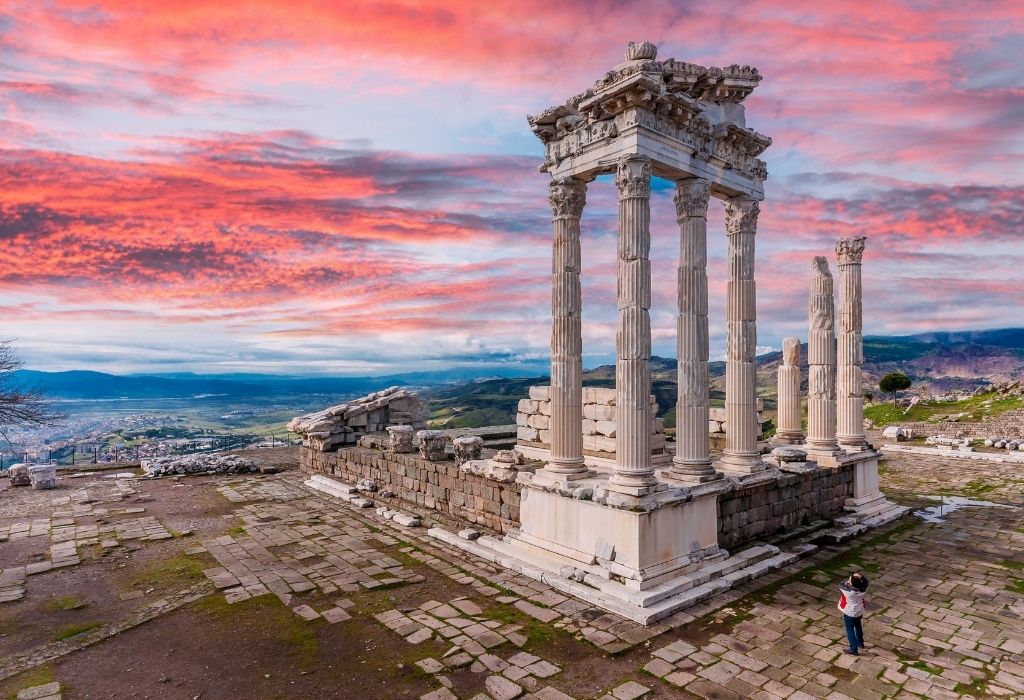I want to continue our exploration from the districts of İzmir. In this metropolitan city, when each district has its own atmosphere and unique texture, it is such a long and fun experience to explore. We are in Bergama this week.
Bergama has an Ancient City that has been included in the UNESCO World Heritage List. Frankly, I thought Bergama was just that. It turns out Bergama with its streets, houses, tradesmen and neighbourhood culture; also is an unpretentious but peaceful place that has resisted time and never changed. So let’s start our tour:
Nostalgic Tour in Bergama Neighborhoods
Kale District: If I’m praising the streets and houses in the Aegean, know that these places are from the Greeks. Just like in Bergama. The neighbourhood where the houses are built with the architecture specific to the Greeks, who had to go during the population exchange period, are concentrated in Kale Mahallesi.
Streets where children play ball and where the flow of life welcomes you here. As I said above, flashy things do not await you here. These are places that remind me of the 90s and will attract the attention of those who are curious about the neighbourhood culture in Turkey’s recent past.
When you follow the road that leads from the neighbourhood toa square, you will come across the Cafeneon Attalos, which was used as a socialization centre by the Greeks. This place is now operated as the Bergama Chamber of Commerce Tavern. Here you can take a break and have something to eat and drink. Located at Ulucami Mah. Büyük Alan Location, Bergama Center.
Atmaca District: There are some districts where the Romany people live in Bergama. One of them is Atmaca. An atmosphere similar to that of Kale Mahallesi welcomes you. But as a different, you come across Romany people playing instruments and dancing on the streets. There is at least one musical instrument in every house here. Many famous Roma musicians in Turkey grew up here. If you want to have more information about Atmaca, visit this link to a documentary made about this place: https://www.facebook.com/watch/?v=221282278973103.
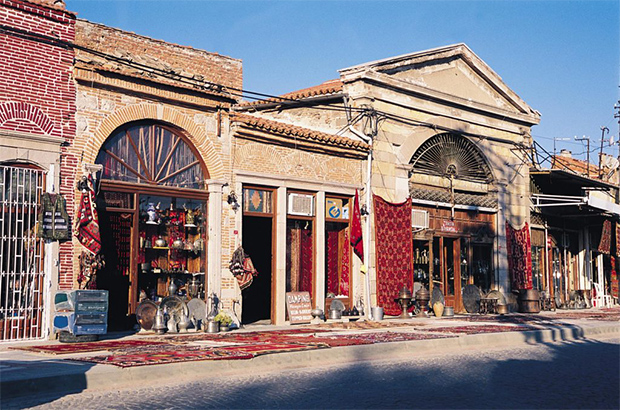
Bergama Centre
Bergama Centre: This was the place that gave me the 90s feel of Türkiye the most. The peddlers, grocers, greengrocers and neighbourhood culture made me feel like I was coming across random photos from my childhood. Those who are interested in subcultures of different countries like me or those who are interested in street photography, for example, can enjoy all of these neighbourhoods.
In the centre, there is a place from the Ottoman period called Arasta, which means bazaar. This is a place where there are small shops and cafes such as basket shops and shoe shops. You can sit and eat and drink in simple and cosy places with mostly wooden tables and chairs. Address Barbaros, Arasta, 35700 Bergama/İzmir
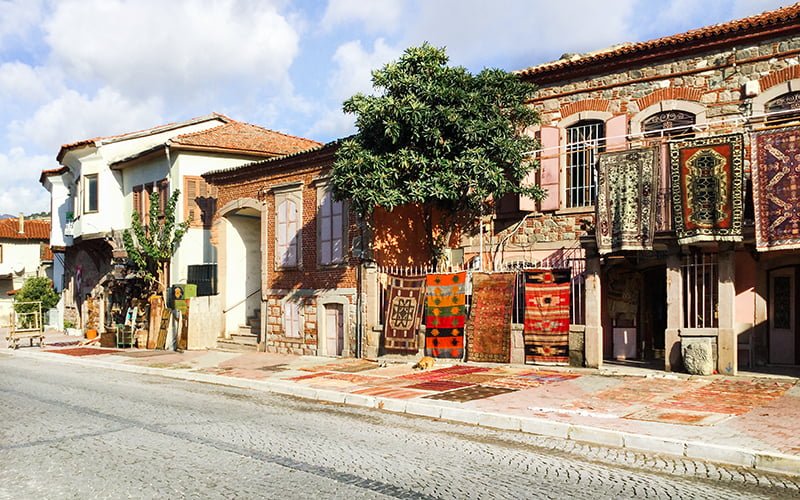
Bergama Carpets
Bergama Carpets
Let’s talk about Bergama carpet, which is a different school in the world with its unique loop technique, colours and pattern structure. Weaving has been practised here in many villages since the 15th century.
Carpet types are divided into four: Kız Bergama, Sarı Namazlık (Yellow Prayer), Yağcıbedir, and Holbein. Many carpet collectors especially like Kız Bergama more. I recommend you see the carpets while you tour.
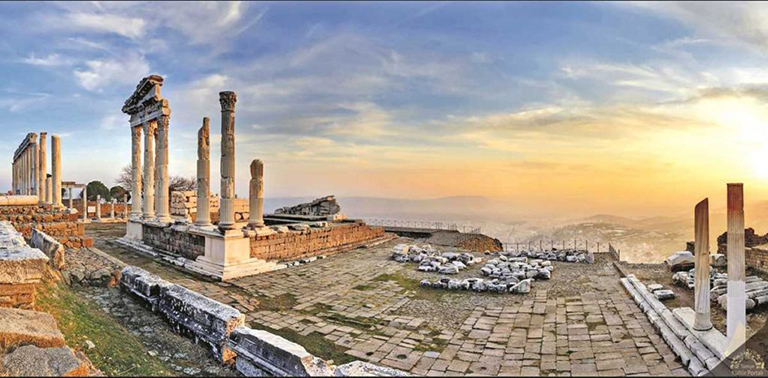
Bergama Ancient City
Bergama Ancient City
Bergama Ancient City is a place of importance in world history. In some ways, it is even portrayed as a world leader of its time. It was a very large and rich kingdom, that later joined to the Roman Empire. In fact, it was the eastern centre of the Roman Empire for a short time before Ephesus.
Many firsts were experienced here. For example, parchment (paper from leather) was found here. The papyrus trade was interrupted when the ties between the Egyptians and the kingdom, who found papyrus (a kind of paper), fell apart.
The king of Pergamon gathered the scientists and ordered them to find a better and more durable paper than papyrus, and thus parchment was found. Following this, the first library in Asia was established here. With a collection of 200,000 volumes, it has become the second-largest library in the world. The amphitheatre in the acropolis is known for being the steepest theatre in the world. Its capacity was 10,000 people.
In fact, although the ancient city spread over a huge geography, it has 2 important places that have survived. One is the Acropolis, which overlooks the city, with the altars, the library and the amphitheatre. This is where the notables of the kingdom lived, as well as the state buildings, the theatre, the famous Altar of Zeus, the palaces, the temples of Athena, Demeter and Trajan and Hadrian, the schools and the agora.
The people, on the other hand, used to live on the lower side of the slope, that is, where the district is established today. For this reason, there are remains of historical houses on the basis of many houses. The second important part of the city that you can see outside the Acropolis is Asklepion, known as the first comprehensive hospital in the world.
This ancient city, which is also on the list of UNESCO, is among the places you must visit. Address: Hamzalısüleymaniye, 35700 Bergama/İzmir. The ancient city can be visited until 18.30.
Asclepion is in a different position. Asklepion has a very important place in the history of medicine as it is where the first known psychotherapy was given, therapeutic drugs were used for the first time and public health policies were produced for the first time. Address: Asclepion is Zafer, Site Sk. No:16.
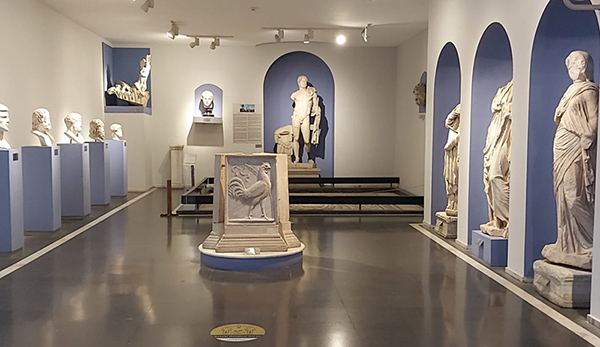
Bergama Archeology Museum
Bergama Archeology Museum
This is a museum where the finds, sculptures and mosaics obtained from the archaeological excavations carried out in the Ancient City of Bergama are exhibited. Those found in the excavation belong to the Early Bronze Period to Byzantium. A part of the museum is devoted to the exhibition of rugs, handicrafts and decoration products belonging to the ethnography of the region. Address Zafer, Cumhuriyet Cd. No:10, 35725 Bergama/Izmir
Sarepeion Temple
This is actually just a part of the Sarepeion, a temple dedicated to the Egyptian underworld god Serapis. Another name is Red Hall Basilica because it is made of red earth. The temple, which was built in the 2nd century during the reign of Roman Emperor Hadrian, was later converted into a church with various additions in the 5th century.
A part of the building, which was later converted into a mosque by the Ottomans, still functions as a mosque today. In short, it is a place that has changed according to the religious beliefs of the people of the region from the time it was built but has managed to survive. Address Islamsaray, Bergama Road, 1st Km.
Let’s Take the Pergamon Scroll
As I mentioned above, parchment was invented here. You may want to visit the souvenir shops where you can buy both parchment and different products. Pergamon Parchment Zafer, Ataturk Blv. no: 54, 35700 Bergama/İzmir. Another shop with the same name is located in Barbaros, 35700 Bergama/İzmir.
Forget Time at Kozak Plateau
Kozak Plateau is a huge green area covered with pine forests between Bergama and Ayvalık. It is a really beautiful forest. Only half an hour from Bergama by car. I think you should definitely add it to your route. Conifer collection period in the plateau is between November and March. The pistachios from the cones have also entered the cuisine of the region. You can drink pistachio tea with pistachio halva in Kozak Life Valley.
What to Eat
In Bergama, you should eat the fried food they call “çığırtma”. Fried veg with a garlic flavour and tomato sauce. There is a Turkish expression like “You want to eat it more while still eating it”. This expression fits with çığırtma. Here are a few restaurant addresses to visit:
Bergama Sofrası; Barbaros, Bankalar Cd. No:44, 35700 Bergama/Izmir
Çığırtma Evi (Çığırtma House); Gazipasa, Doganci Cd. No:5725, 35700 Bergama/Izmir
Acropolis Restaurant; Ulucami, 35700 Bergama/İzmir
You may also want to stop by the breakfast place, which is famous (almost 100 years old) thanks to its elderly owner. Thanks to the honey and cream breakfast you will have here, you will have good energy for visiting the Ancient City. I also liked Yeni Gün, meaning a new day, and is loctaed at Talatpaşa, Değirmen Sk. No:4.
Reaching Bergama
To tour Bergama properly; to visit both the ancient city, the plateau and the centre, I recommend you go by car. But if you are considering a more limited trip or prefer to take a taxi in Bergama (make sure the driver turned on the taximeter), you can go to İzmir from Didim Bus Terminal. From there, get the Bergama minibus, which depart from platform 142 from the second floor of Izmir Bus Station. Minibuses arrive in Bergama in 1 to 1.5 hours. Have a nice trip.
